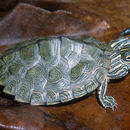Lifespan, longevity, and ageing
provided by AnAge articles
Maximum longevity: 14.5 years (captivity)
- license
- cc-by-3.0
- copyright
- Joao Pedro de Magalhaes
- editor
- de Magalhaes, J. P.
Biology
provided by Arkive
Cagle's map turtle is a diurnal species that spends much of the day basking on logs and rocks in the water. A predominantly aquatic species, this turtle rarely comes onto land other than to nest (8). Hatchlings have been collected from September through November, indicating that the nesting season likely occurs in late spring to early summer (2). As many as three clutches of one to six eggs may be laid by a single female each year, deposited in nest-cavities approximately 15 centimetres deep near the water (2) (8). Sex is temperature-dependent, with lower nest temperatures producing males and higher temperatures producing females (8).
Female Cagle's map turtle feed almost exclusively on Asian clams, while the males predominantly consume caddisfly larvae, and occasionally other insects and small molluscs (9). This difference in diet is correlated to the difference in head-width between the sexes (6). Plant remains have also been found in specimen's stomachs, but are thought to have been ingested incidentally (2) (8).
Conservation
provided by Arkive
Cagle's map turtle is listed as Threatened in Texas and is therefore protected within the state (4).
Description
provided by Arkive
Map turtles are so named for the distinctive fine lines covering their skin and upper shell (carapace), which somewhat resemble a road or contour map, and lend an air of beauty and elegance to these species that is hard to equal (3). Like most turtles found in the green-tinted rivers it occupies, Cagle's map turtle is a distinctive greenish colour (4), and arguably one of the most attractive of all map turtles (5). The upper shell is serrated at the back, bears a steep keel of sharp spine-like projections down the centre (2), and is brightly patterned with black and yellow-green concentric lines and circles (5). The head, limbs and tail are black with numerous cream to yellow lines, and there is a cream-coloured bar on the chin and a yellow 'V'-shaped mark on the top of the head (2) (5). Female Cagle's map turtles are larger than males and also have broader heads (6).
Habitat
provided by Arkive
Generally found in shallow limestone and mud-bottomed streams with moderate currents, and in pools up to three metres in depth (2) (8).
Range
provided by Arkive
Restricted to the Guadalupe River and its tributaries, the San Marcos and Blanco Rivers, of south-eastern Texas, U.S. (2) (7).
Status
provided by Arkive
Classified as Vulnerable (VU) on the IUCN Red List 2007 (1).
Threats
provided by Arkive
Relatively little is documented on the threats that face Cagle's map turtle, other than the fact that its habitat is constantly being threatened by siltation, impoundment and other forms of habitat alteration (10).
Distribution
provided by ReptileDB
Continent: North-America
Distribution: USA (Guadalupe and San Antonio river drainages in SC Texas)
Type locality: Guadalupe River, 8 km NW Cuero, DeWitt Co, Texas, USA.
Cagle's map turtle
provided by wikipedia EN
Cagle's map turtle (Graptemys caglei) is a species of turtle in the family Emydidae. The species is endemic to Texas, where it is native to the Guadalupe, San Antonio, and San Marcos Rivers.[4]
Etymology
The specific name, caglei, is in honor of American herpetologist Dr. Fred Ray Cagle (1915–1968).[5]
Description
Cagle's map turtle has intricate patterns on the carapace and plastron, as well as serrated edges on the posterior of the carapace, as is typical of all map turtles. It is smaller than most map turtles, and very sexually dimorphic, with males reaching only 4 in (10 cm) straight carapace length, while females can exceed 7 in (18 cm) in straight carapace length.[4]
Diet
Adult females of G. caglei feed mainly on molluscs, but males and juveniles feed mainly on aquatic insects.[1]
Reproduction
Like all turtles, G. caglei is oviparous.[6] A sexually mature female may lay up to three clutches of eggs in a year.[1] Clutch size is small, only one to six eggs.[1]
References
- license
- cc-by-sa-3.0
- copyright
- Wikipedia authors and editors
Cagle's map turtle: Brief Summary
provided by wikipedia EN
Cagle's map turtle (Graptemys caglei) is a species of turtle in the family Emydidae. The species is endemic to Texas, where it is native to the Guadalupe, San Antonio, and San Marcos Rivers.
- license
- cc-by-sa-3.0
- copyright
- Wikipedia authors and editors

